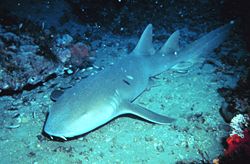Nurse sharks
| Ginglymostomatidae Temporal range: Upper Jurassic–Recent |
|
|---|---|
 |
|
| Ginglymostoma cirratum | |
| Scientific classification | |
| Kingdom: | Animalia |
| Phylum: | Chordata |
| Class: | Chondrichthyes |
| Subclass: | Elasmobranchii |
| Order: | Orectolobiformes |
| Family: |
Ginglymostomatidae T. N. Gill, 1862 |
| Genera | |
|
Ginglymostoma |
|
Ginglymostoma
Nebrius
Pseudoginglymostoma
The Ginglymostomatidae are a cosmopolitan family of carpet sharks, containing two monotypic genera of nurse sharks. Common in shallow, tropical and subtropical waters, these sharks are sluggish and docile bottom-dwellers. Nurse sharks typically attack humans only if directly threatened.
The name nurse shark is thought to be a corruption of nusse, a name which once referred to the catsharks of the family Scyliorhinidae. The nurse shark family name, Ginglymostomatidae, derives from the Greek words ginglymos (γίγγλυμος) meaning "hinge" and stoma (στόμα) meaning "mouth".
The largest species, called simply the nurse shark Ginglymostoma cirratum, may reach a length of 4.3 m (14 ft); the tawny nurse shark Nebrius ferrugineus is somewhat smaller at 3.2 m (10 ft), and the short-tail nurse shark Pseudoginglymostoma brevicaudatum is by far the smallest at just 75 cm (2.46 ft) in length. The first of the three species may reach a weight of 110 kg. Yellowish to dark brown in colour, nurse sharks have muscular pectoral fins, two spineless dorsal fins (the second of which is smaller) in line with the pelvic and anal fins, and a tail exceeding one quarter the shark's body length.
The mouth of nurse sharks is most distinctive; it is far ahead of the eyes and before the snout (subterminal), an indication of the bottom-dwelling (benthic) nature of these sharks. Also present on the lower jaw are two fleshy barbels, chemosensory organs which help the nurse sharks find prey hidden in the sediments. Behind each eye is a very small, circular opening called a spiracle, part of the shark's respiratory system. The serrated teeth are fan-shaped and independent; like other sharks, the teeth are continually replaced throughout the animal's life.
...
Wikipedia
